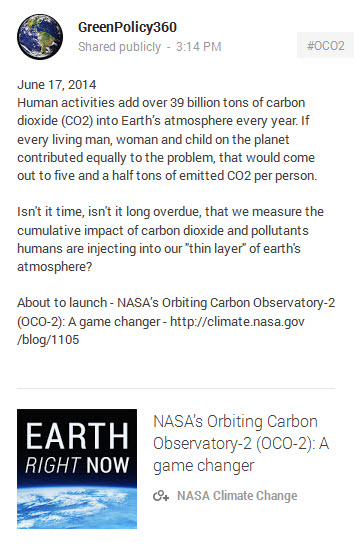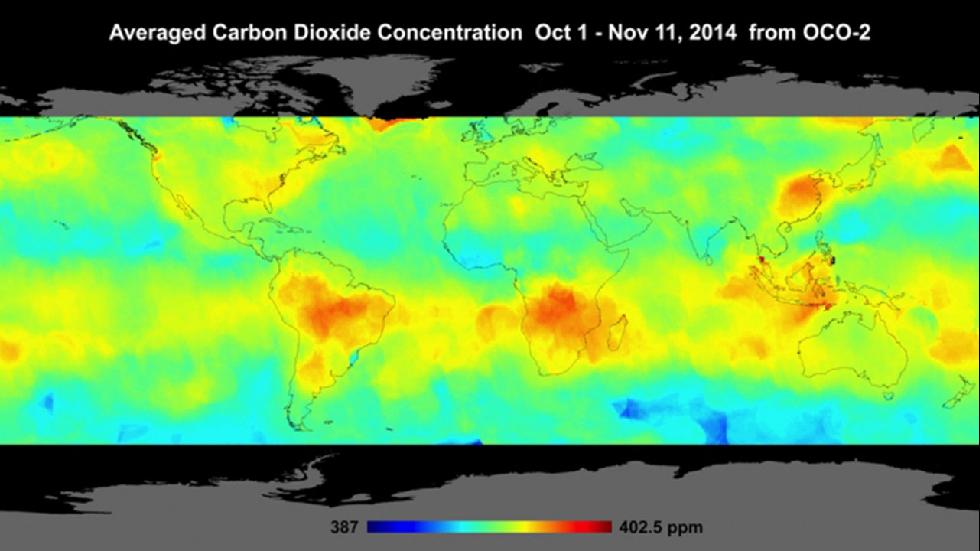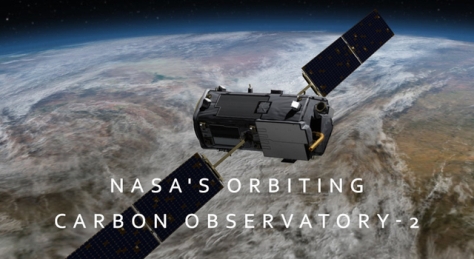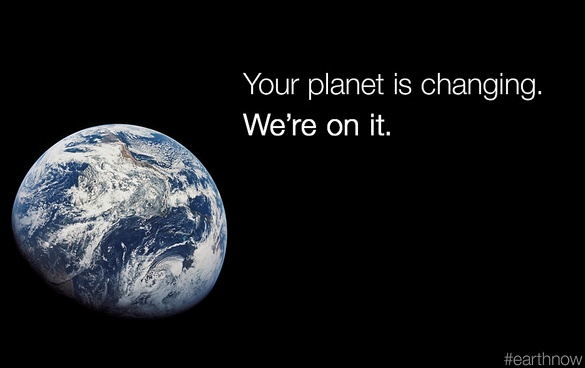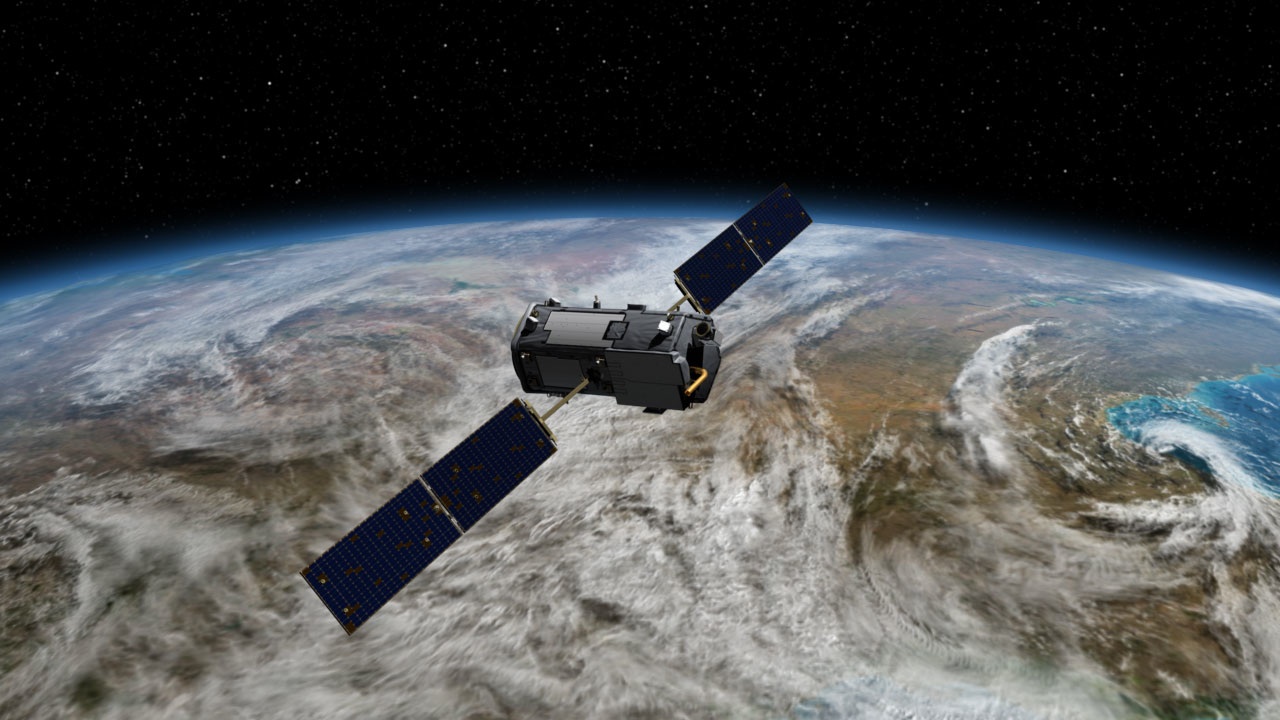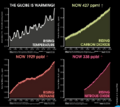Category:Earth Observations
Updates: June 2015
http://www.greenpolicy360.net/w/Aquifers
"Time to depletion" -- "Significant segments of Earth's population are consuming groundwater quickly without knowing when it might run out..."
"Available physical and chemical measurements are simply insufficient," said UCI professor and principal investigator Jay Famiglietti, who is also the senior water scientist at NASA's Jet Propulsion Laboratory in Pasadena, California. "Given how quickly we are consuming the world's groundwater reserves, we need a coordinated global effort to determine how much is left."
The studies are the first to comprehensively characterize global groundwater losses with data from space, using readings generated by NASA's twin GRACE satellites.
○
Earth Observation Science Initiatives Grow in Importance
Groundwater Basins in Distress
The GRACE mission reports home -- http://touch.latimes.com/#section/-1/article/p2p-83799955/ -- http://www.nzherald.co.nz/world/news/article.cfm?c_id=2&objectid=11466534
http://mashable.com/2015/06/16/groundwater-aquifers-depleted/ -- http://www.washingtonpost.com/blogs/wonkblog/wp/2015/06/16/new-nasa-studies-show-how-the-world-is-running-out-of-water/
○
Environmental Security: Earth Science Programs Cut
http://www.greenpolicy360.net/w/File:Presidents_budget_see_earth_science.jpg
http://www.greenpolicy360.net/w/File:House_budget_see_earth_science.jpg
Re: funding cuts to NASA's critical Earth science and space technology programs
On May 1, 2015, White House Office of Science and Technology Policy Director Dr. John P. Holdren issued the following statement on proposed funding cuts to NASA's critical Earth science and space technology programs:
"If enacted, the NASA authorization bill headed to the House floor later this month would do serious damage to the Nation’s space program, as well as to Earth-observation and Earth-science programs essential for predicting, preparing for, and minimizing the damage from disasters both natural and human-induced.
The House bill would also gut the NASA “mission to planet Earth”—the satellite observations and related research that provide key measurements and insights relevant to forecasting and tracking hurricanes, fighting wildfires, observing the state of the world’s farms and forests, mapping the extent of droughts, measuring the stocks of groundwater, and monitoring the likelihood of landslides. The draconian cuts in the House bill would also delay advances in our ability to research and prepare for volcanic eruptions, earthquakes, and tsunamis and blind us to changes in the Earth’s oceans and ice sheets that can be discerned only from space."
New Definitions of National Security
○ ○ ○ ○ ○ ○ ○ ○ ○ ○ ○ ○ ○ ○ ○ ○ ○ ○ ○ ○
http://www.greenpolicy360.net/w/Earth_Right_Now
https://twitter.com/hashtag/EarthRightNow?src=hash
http://science.nasa.gov/earth-science/
http://www.nasa.gov/topics/earth/index.html
○ ○ ○ ○ ○ ○ ○ ○ ○ ○ ○ ○ ○ ○ ○ ○
December 2014
Historic Orbiting Carbon Observatory Satellite Sends Back Most Detailed CO2 View Ever / Dec 18, 2014
Initial OCO-2 data available in March for scientists and public to download and explore
Phys.org - Discovery - Weather - Nature
Sample Data -- OCO-2 Data Portal
○ ○ ○ ○
○ ○ ○ ○
November
Counting carbon over Southern California - OCO-2 at work
October
September
August
August 13th/Climate Central news report of first data
July 2 2014
- Watching the Planet Breathe
NASA Launches New Carbon-Sensing Mission to Monitor Earth’s 'Breathing'
"Climate change is the challenge of our generation," says NASA Administrator Charles Bolden
- Follow the OCO-2 Mission
Follow the tweets of the OCO-2 bird
Follow the NASA climate blog
http://climate.nasa.gov/blog/1105/ -- http://climate.nasa.gov/blog/
"Game changing" science Unraveling mysteries
○ ○ ○ ○ ○ ○ ○ ○ ○ ○ ○ ○ ○ ○ ○ ○
- Climate Change, Global Warming
Observing Global Warming with #OCO-2
Historic launch #PlanetCitizen mission to study #EarthsAtmosphere
"First Light!" [1] [2] OCO-2 announces 'We have data!'
OCO-2 tweets - https://twitter.com/IamOCO2
What monitoring a potential existential crisis looks like...spectra from #OCO-2 #Earth360
Earth observing satellites, Orbiting Carbon Observatory the "Afternoon Constellation", the "A-Train" joined by #OCO-2 newly launched and historic in its mission to study global warming
"Watching the Earth Breathe from Space" [3] [4] [5] [6]
About the Earth Observatory Mission
○ ○ ○ ○ ○ ○ ○ ○ ○ ○ ○ ○ ○ ○ ○ ○
With the launch of OCO-2, a "game changer", the data of #Earth360 will grow in unprecedented ways
#Earthdata enables informed decisions and policy
"You can manage only what you can measure"
○ ○ ○ ○ ○ ○ ○ ○ ○ ○ ○ ○ ○ ○ ○ ○
Eyes on the Earth [7] [8] [9] [10]
○ ○ ○ ○ ○ ○ ○ ○ ○ ○ ○ ○ ○ ○ ○ ○ ○ ○ ○
Global Earth Science Data Links
eGY -- electronic Geophysical Year / http://www.egy.org/ -- An Earth and Space Science Information Commons Initiative: International Co-operation for Open Access to Data
GEO -- Group on Earth Observations / http://www.earthobservations.org/index.php -- Established in 2005, GEO is a voluntary partnership of governments and organizations that envisions “a future wherein decisions and actions for the benefit of humankind are informed by coordinated, comprehensive and sustained Earth observations and information.”
CEOS -- Committee On Earth Observation Satellites / http://ceos.org/ -- 2015 - CEOS was established in September, 1984 in response to a recommendation from a Panel of Experts on Remote Sensing from Space and set up under the aegis of the G7 Economic Summit of Industrial Nations Working Group on Growth, Technology, and Employment.
This Panel recognized the multidisciplinary nature of space-based Earth observations and the value of coordinating international Earth observation efforts to benefit society. Accordingly, the original function of CEOS was to coordinate and harmonize Earth observations to make it easier for the user community to access and use data. CEOS initially focused on interoperability, common data formats, the inter-calibration of instruments, and common validation and inter-comparison of products. However, over time, the circumstances surrounding the collection and use of space-based Earth observations have changed.
- The number of Earth-observing satellites has vastly increased.
- Onboard instruments are more complex and are capable of collecting new types of data in ever-growing volumes.
- The user community has expanded and become more diverse as different data types become available and new applications for Earth observations are developed.
Users have become more organized, forming several international bodies that coordinate and levy Earth observation requirements.
CEOS WGISS -- Committee On Earth Observation Satellites / http://ceos.org/ourwork/workinggroups/wgiss/ -- Working Group on Information Systems and Services - WGISS stimulates, coordinates, monitors, and promotes collaboration on the development of the systems and services that manage and supply satellite Earth observation (EO) data and information.
CEOS IDN -- Committee On Earth Observation Satellites / http://idn.ceos.org/ -- International Directory Network (IDN) / http://idn.ceos.org/portals/Home.do?Portal=idn_ceos&MetadataType=0 -- The CEOS International Directory Network (IDN) is a Gateway to the world of Earth Science data and services. The CEOS IDN is an international effort developed to assist researchers in locating information on available datasets and services. The directory is sponsored as a service to the Earth science community.
GCMD -- Global Change Master Directory / http://gcmd.nasa.gov/
DIF -- DIF Writer's Guide / http://gcmd.gsfc.nasa.gov/add/difguide/index.html -- Directory Interchange Forma... The DIF does not compete with other metadata standards. It is simply the "container" for the metadata elements that are maintained in the IDN database, where validation for mandatory fields, keywords, personnel, etc. takes place. The DIF is used to create directory entries which describe a group of data. A DIF consists of a collection of fields which detail specific information about the data. Eight fields are required in the DIF; the others expand upon and clarify the information. Some of the fields are text fields, others require the use of controlled keywords...Directory Interchange Format (DIF) Writer's Guide, 2015. Global Change Master Directory. National Aeronautics and Space Administration. http://gcmd.nasa.gov/add/difguide/ - http://gcmd.nasa.gov/ -- Global Change Master Directory
GGOS -- GGOS at the GFZ Potsdam / http://www.ggos.org/ -- GGOS is the Observing System of the International Association of Geodesy (IAG). GGOS works with the IAG components to provide the geodetic infrastructure necessary for monitoring the Earth system and for global change research. It provides observations of the three fundamental geodetic observables and their variations, that is, the Earth's shape, the Earth's gravity field and the Earth's rotational motion. GGOS integrates different geodetic techniques, different models, different approaches in order to ensure a long-term, precise monitoring of the geodetic observables in agreement with the Integrated Global Observing Strategy (IGOS)
IVOA -- International Virtual Observatory Alliance (IVOA) / http://www.ivoa.net/ -- The Virtual Observatory (VO) is the vision that astronomical datasets and other resources should work as a seamless whole. Many projects and data centres worldwide are working towards this goal. The International Virtual Observatory Alliance (IVOA) is an organisation that debates and agrees the technical standards that are needed to make the VO possible.
DLR -- Deutsches Zentrum für Luft- und Raumfahrt / http://www.dlr.de/dlr/en/desktopdefault.aspx/tabid-10002/
JPL -- Jet Propulsion Laboratory - California Institute of Technology / http://www.jpl.nasa.gov/
PO.DAAC -- Physical Oceanography Distributed Active Archive Center PO.DAAC / http://podaac.jpl.nasa.gov/
INDIGO -- Inter-service Data Integration for Geodetic Operations / http://indigo.nasa.gov/
UTCSR -- University of Texas at Austin - Center for Space Research / http://www.csr.utexas.edu/ - GRACE mission status / http://www.csr.utexas.edu/grace/operations/mission_status/ - http://podaac.jpl.nasa.gov/grace/ - http://isdc.gfz-potsdam.de/index.php?module=pagesetter&func=viewpub&tid=1&pid=35
DGFI -- Deutsches Geodätisches Forschungsinstitut / http://www.dgfi.tum.de/en/
IAG -- IAG Services - International Association of Geodesy / http://www.iag-aig.org/index.php?tpl=text&id_c=1&id_t=102
ICGEM -- International Centre for Global Earth Models / http://icgem.gfz-potsdam.de/ICGEM/ICGEM.html
PV 2007 -- PV 2007: Proceedings and Results / http://pv2007.dlr.de/main/results_en.htm
Paper: The ISDC concept for long-term sustainability of geoscience data and information / http://pv2007.dlr.de/Papers/Ritschel_ISDC.pdf
IUGG 2007 -- Proceedings of IUGG XXIV General Assembly / UNION SYMPOSIA Proceedings - Earth: Our Changing Planet / http://www.iugg2007perugia.it/webbook/download.htm
VOiG -- Virtual Observatories in Geosciences (VOIG) Conference 2007 / http://www.egy.org/VOiG/Home.html
○ ○ ○ ○ ○ ○ ○ ○ ○ ○ ○ ○ ○ ○ ○ ○ ○ ○ ○ ○ ○ ○ ○ ○ ○ ○ ○ ○ ○ ○ ○ ○
Earth Observation from Space: GreenPolicy Links - 2014
NASA's Earth Science Enterprise (ESE) -- Originally called "Mission to Planet Earth (MTPE)"
![]()
October 2014 http://bit.ly/VitalSignsPulseofthePlanet / Video To fully appreciate the detail of the models, click on the gear symbol and set to 720p resolution and choose full screen video
ESE is dedicated to "understanding the total Earth system and the effects of natural and human-induced changes on the global environment." [11]
Mission to Planet Earth's successor, NASA’s Earth Observing System (EOS), provides long-term global observations of the land surface, biosphere, solid Earth, atmosphere, and oceans.
Earth Observing System Data and Information System - Maps
Suomi NPP - Next-generation Earth-observing satellite system NPP Images Gallery
Next generation NASA-NOAA #EarthMonitoring satellite to launch in 2017
"The ultimate beneficiaries are the present and future generations of the people on Earth..."
The goal of the Earth Observing project is "improved understanding of the Earth as an integrated system."
ESE's Mission: "To improve life here" and "to understand and protect our home planet."
#EarthScience, #GeoScience, #Earth360, #GP360, #EarthPOV
Eyes on the Earth-Earth Right Now, Earth Observing System Project, Earth Data, Earth Observatory, [12], Grace, Grace-JPL, Grace-UTexas
Visible Earth, Global Maps, Visible Earth_2, Visible Earth_3, Visible Earth_4, Earth Mission List
ICESat-2 [13] - [14] Video of ICESat's laser in operation ICESat-2 science at work...
Monitoring #Earth at night [15] [16] [17] [18]
○
European space program - earth system monitoring
European Space Agency "Living Planet Programme" managed by Earth Observation Programmes - [19]
- GOCE – Gravity Field and Steady-State Ocean Circulation Explorer - launched on March 17, 2009 - [20]
- SMOS – Soil Moisture and Ocean Salinity satellite - studying ocean salinity and soil moisture; launched in 2 November 2009 - [21]
- CryoSat is designed to map the Earth's ice cover. CryoSat-2 was launched 8 April 2010 - [22] - Euro Cryo Satellite/Earth Imaging
◊ Geo-science: Eyes in the Sky Antarctic Ice Loss Antarctic Ice Sheet Expands, Why?
- Swarm – is a trio of satellites to map the Earth's magnetism. The SWARM constellation was launched successfully on 22 November 2013 - [23]
- Aeolus – Atmospheric Dynamics Mission will use an innovative laser to measure winds. Due for launch in 2015 - [24]
- EarthCARE – Earth Clouds Aerosols and Radiation Explorer will examine the formation and effects of clouds. Due for launch in 2016 - [25]
- BIOMASS is designed to calculate the amount of carbon stored in the world's forests, and to monitor for any changes over the course of its five-year mission. Due to launch in 2020 - [26]
○
Subcategories
This category has the following 16 subcategories, out of 16 total.
A
C
D
E
F
G
N
P
S
W
Pages in category "Earth Observations"
The following 176 pages are in this category, out of 176 total.
3
A
C
- C40 Cities Climate Leadership Group
- Carbon Brief
- Citizen Science
- Clearcutting
- Climate Change - Global Warming Keyword-Terms
- Climate Change Denier Talking Points -- and Rebuttals
- Climate Change Summit Paris
- Climate Conference - Paris 2015
- Climate Desk
- Climate Law Blog @Columbia Law School
- Climate migration
- Climate News
- Climate News Events Archive ... 1970 to Today
- Climate Plans Enforcement - Resources
- Climate Problems, Climate Solutions
- Copernicus EU
- Creatively Green
D
E
- Each of us can make a positive difference
- Earth
- Earth and Space, Politics
- Earth Day
- Earth Day 2020
- Earth Day Memories on the 50th Anniversary
- Earth Day Summit - April 22 2021
- Earth from NASA
- Earth Imaging-New Space
- Earth Observation Portal
- Earth Right Now
- Earth Science
- Earth Science Eco-Fields
- Earth Science Research from Space
- Earth Science Vital Signs
- EarthPOV
- Earthrise
- EarthTime
- Earthviews
- Earthviews from Astronauts
- Eco-nomics
- Ecolivia
- Environmental agreements
- Environmental full-cost accounting
- Environmental Rules Rolled Back
- Environmental Security Organizations
- EOS eco Operating System
- ESA Living Planet Announcement - May 2022
- Ethics and Climate Change
- European Union Green Deal - Fit for 55
- Extinction
- ExxonMobil and US House Science Committee v US Attorneys General and Environmental Groups
F
G
- Generation Green
- Geoengineering
- George E. Brown Jr
- Glasgow Climate Summit - Pledges, Promises, Declarations - What's Next Up
- Global Citizen
- Global Climate Action Summit
- Global Fishing Watch
- Global Forest Watch
- Global Risks Report
- Going Green: Texas v. Pennsylvania
- Google Earth
- Google Earth Timelapse
- GP360 NewPages
- Green Bank in Maryland - and More
- Green Politics 360
- Green Politics with GreenPolicy360
- Green Quotes
- Green Stories of the Day
- Green Stories of the Day - GreenPolicy360 Archive
- GreenAction
- Greening Our Blue Planet
- GreenPolicy360 Archive Highlights 2013
- GreenPolicy360 Archive Highlights 2014
- GreenPolicy360 Archive Highlights 2015
- GreenPolicy360 Archive Highlights 2016
- GreenPolicy360 Archive Highlights 2017
- GreenPolicy360 Archive Highlights 2018
- GreenPolicy360 Archive Highlights 2019
- GreenPolicy360 Archive Highlights 2020
- GreenPolicy360 Archive Highlights 2023
- GreenPolicy360 Highlights
- Ground Truth
I
L
N
O
P
- Pale blue dot
- Paris climate change conference, Dec12, 2015 report from Rebecca Solnit
- PeoplesClimateMarch
- Permaculture Green Practices
- Permafrost
- Pictures from ISS
- Planet API
- Planet Citizen Action
- Planet Citizen Vision of Living Earth
- Planet Citizens
- Planet Citizens, Planet Scientists
- Planet Earth Perspective
- Planet Labs Doves Fly
- Planet of the Humans, a documentary film
- Planetary.org
- PlanetCitizen
S
T
U
W
Media in category "Earth Observations"
The following 10 files are in this category, out of 1,411 total.
(previous page) (next page)- World Oil Report - Dec2016.png 694 × 670; 203 KB
- Worldwide view of oceans phytoplankton earth observatory nasa.gif 540 × 270; 0 bytes
- WV v EPA SCOTUS poll - June 27 2022 before court decision.png 623 × 480; 126 KB
- You are here 1.jpg 778 × 367; 129 KB
- Your Place in Space.jpg 851 × 315; 38 KB
- Youth Climate Movement.jpg 516 × 284; 79 KB
- Youth Climate Strikes-March15,2019.jpg 707 × 639; 159 KB
- Zack Labe - climate viz - June 2024.png 675 × 600; 261 KB
- Aquifers
- Biodiversity
- Citizen Science
- Climate Change
- Earth360
- Earth Law
- Earth Science
- Earth Science from Space
- Ecology Studies
- Environmental Full-cost Accounting
- Environmental Security
- Environmental Security, National Security
- EOS eco Operating System
- Externalities
- Land Ethic
- New Space
- Permaculture
- Planet API
- Planet Citizen
- Planet Scientist
- Planet Citizens, Planet Scientists
- Planetary Science
- Sustainability
- Sustainability Policies
- ThinBlueLayer
- Virtual Earth
- Virtual Planet
- Water
- Whole Earth
- Atmospheric Science
- Biogeosciences
- Cryosphere
- Geology
- Geophysics
- Geophysics and Geochemistry
- Hydrology
- Mineralogy
- Natural Resources
- Ocean Science
- Space Science and Space Physics

